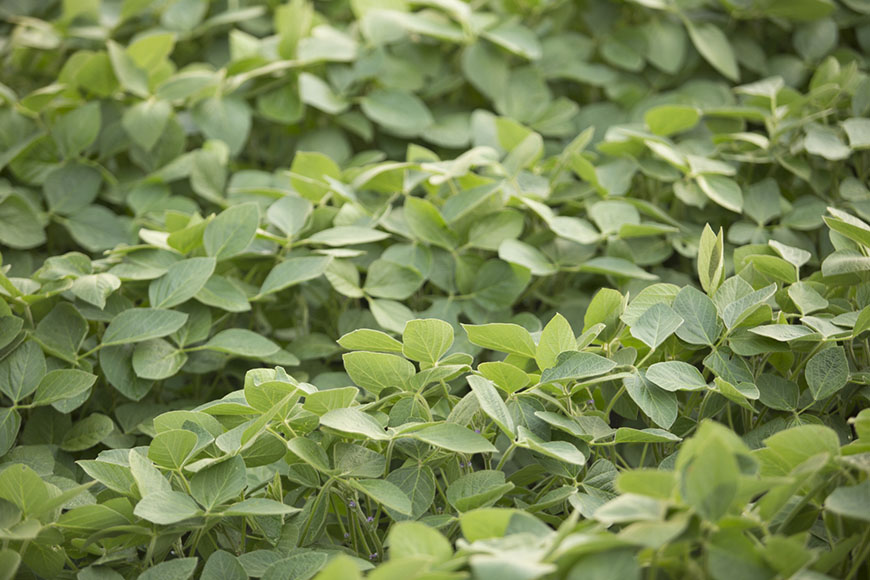Make Every Soybean Count at Harvest

As we near the finish line with this year’s soybean crop, it’s time to focus on capturing the maximum number of bushels at harvest. Losing just three to four soybeans per square foot can reduce yield by 1 bushel per acre and quickly take a bite out of bottom-line profit potential.
The following are a few reminders for success this harvest season.
1. Scout fields now. Scouting soybean fields before harvest can help identify and mitigate potential harvest challenges. For example, if weeds are a problem, you might consider a late-season herbicide application to alleviate combining issues. Also be sure to check label restrictions and pre-harvest intervals.
2. Inspect harvest equipment. Take time to make sure all equipment is in optimal working condition before heading to the field. Review the combine’s standard settings and inspect all key parts, such as belts, chains and the auger. Pay special attention to the condition of cutter bars and knives to help avoid losses at the head.
3. Monitor moisture levels. Keep a close eye on each field’s moisture levels to help prioritize harvest order to avoid soybean shatter and split issues. Harvesting at moistures between 13 and 15 percent minimizes harvest losses, splits and dockage at the elevator. Moisture below that range can accelerate shatter and split problems. Where shatter losses appear likely, harvesting earlier or later in the day, when higher humidity increases pod moisture levels, helps minimize the problem.
4. Consider weedy fields. Clean out the combine after harvesting fields with hard-to-control weeds such as waterhemp and other tough species to prevent them from spreading to other fields. You could also consider harvesting weedy patches or even the entire field last to avoid spreading weed seeds to other locations.
5. Match equipment settings to conditions. Soybean losses can be minimized by adjusting combine settings to match crop conditions. For example, if drought conditions caused shorter soybean plants, adjust the cutter bar and reel height accordingly to obtain as much yield as possible. Also, monitor cutterbar performance as well as cylinder-concave settings to reduce the pass-through of pods that still contain soybeans. Combining at reduced speeds (< 3 mph) can help minimize harvest losses and may be necessary where there are green stems at harvest.
6. Gather data for next season. Pay attention to the yield monitor and observe high- and low-yielding areas of each field. Try to determine what caused those results so you can either replicate that success or plan to alleviate losses the next time.
The following are a few reminders for success this harvest season.
1. Scout fields now. Scouting soybean fields before harvest can help identify and mitigate potential harvest challenges. For example, if weeds are a problem, you might consider a late-season herbicide application to alleviate combining issues. Also be sure to check label restrictions and pre-harvest intervals.
2. Inspect harvest equipment. Take time to make sure all equipment is in optimal working condition before heading to the field. Review the combine’s standard settings and inspect all key parts, such as belts, chains and the auger. Pay special attention to the condition of cutter bars and knives to help avoid losses at the head.
3. Monitor moisture levels. Keep a close eye on each field’s moisture levels to help prioritize harvest order to avoid soybean shatter and split issues. Harvesting at moistures between 13 and 15 percent minimizes harvest losses, splits and dockage at the elevator. Moisture below that range can accelerate shatter and split problems. Where shatter losses appear likely, harvesting earlier or later in the day, when higher humidity increases pod moisture levels, helps minimize the problem.
4. Consider weedy fields. Clean out the combine after harvesting fields with hard-to-control weeds such as waterhemp and other tough species to prevent them from spreading to other fields. You could also consider harvesting weedy patches or even the entire field last to avoid spreading weed seeds to other locations.
5. Match equipment settings to conditions. Soybean losses can be minimized by adjusting combine settings to match crop conditions. For example, if drought conditions caused shorter soybean plants, adjust the cutter bar and reel height accordingly to obtain as much yield as possible. Also, monitor cutterbar performance as well as cylinder-concave settings to reduce the pass-through of pods that still contain soybeans. Combining at reduced speeds (< 3 mph) can help minimize harvest losses and may be necessary where there are green stems at harvest.
6. Gather data for next season. Pay attention to the yield monitor and observe high- and low-yielding areas of each field. Try to determine what caused those results so you can either replicate that success or plan to alleviate losses the next time.

